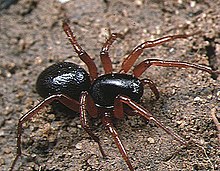Ant spider
| Ant spiders | |
|---|---|
 | |
| female Mallinella fulvipes | |
Scientific classification | |
| Kingdom: | Animalia |
| Phylum: | Arthropoda |
| Subphylum: | Chelicerata |
| Class: | Arachnida |
| Order: | Araneae |
| Suborder: | Opisthothelae |
| Infraorder: | Araneomorphae |
| Family: | Zodariidae Thorell, 1881[1] |
| Genera | |
See text. | |
Diversity[2] | |
84 genera, 1126 species | |
 | |

male Mallinella fulvipes

female Mallinella shimojanai
Ant spiders are members of the family Zodariidae. They are small to medium-sized eight-eyed spiders found world-wide in tropical to warm temperate regions, though there are relatively few species in North America.
Some zodariids are ant mimics. Although ant mimicry is quite common in spiders, the form it takes in the zodariids is unusual because, although each species bears a morphological resemblance to the species of ant that forms its prey, the resemblance is not particularly close. It is enhanced by the spider's behaviour. The spiders live in association with a nest of ants of their prey species, and use their mimicry to enter and leave the nest unmolested (if the ants detected them as intruders they would mass to repel and perhaps kill them). The spiders walk on only the three rear pairs of legs, and if they encounter an ant during their forays into the nest territory, they touch their front legs to the ant's antennae in the same way as another ant would with its own antennae. If they have already captured an ant, they then offer that towards the challenging ant, which inspects it and behaves towards the spider as if it were another ant carrying a dead conspecific away from the nest (a common behaviour among ants).
It is likely that the spiders also derive some protection against predation from their similarity to the ants, since ants are unpalatable to many species that eat spiders.
Contents
1 Genera
2 See also
3 References
4 External links
Genera
As of April 2017[update], the World Spider Catalog accepted the following genera:[1]
Acanthinozodium Denis, 1966
Akyttara Jocqué, 1987
Amphiledorus Jocqué & Bosmans, 2001
Antillorena Jocqué, 1991
Asceua Thorell, 1887
Aschema Jocqué, 1991
Asteron Jocqué, 1991
Australutica Jocqué, 1995
Ballomma Jocqué & Henrard, 2015
Basasteron Baehr, 2003
Caesetius Simon, 1893
Capheris Simon, 1893
Cavasteron Baehr & Jocqué, 2000
Chariobas Simon, 1893
Chilumena Jocqué, 1995
Cicynethus Simon, 1910
Colima Jocqué & Baert, 2005
Cryptothele L. Koch, 1872
Cybaeodamus Mello-Leitão, 1938
Cydrela Thorell, 1873
Cyrioctea Simon, 1889
Diores Simon, 1893
Dusmadiores Jocqué, 1987
Epicratinus Jocqué & Baert, 2005
Euasteron Baehr, 2003
Euryeidon Dankittipakul & Jocqué, 2004
Forsterella Jocqué, 1991
Habronestes L. Koch, 1872
Heliconilla Dankittipakul, Jocqué & Singtripop, 2012
Heradida Simon, 1893
Heradion Dankittipakul & Jocqué, 2004
Hermippus Simon, 1893
Hetaerica Rainbow, 1916
Holasteron Baehr, 2004
Ishania Chamberlin, 1925
Lachesana Strand, 1932
Leprolochus Simon, 1893
Leptasteron Baehr & Jocqué, 2001
Leviola Miller, 1970
Lutica Marx, 1891
Malayozodarion Ono & Hashim, 2008
Mallinella Strand, 1906
Mallinus Simon, 1893
Masasteron Baehr, 2004
Mastidiores Jocqué, 1987
Microdiores Jocqué, 1987
Minasteron Baehr & Jocqué, 2000
Neostorena Rainbow, 1914
Nostera Jocqué, 1991
Nosterella Baehr & Jocqué, 2017
Notasteron Baehr, 2005
Omucukia Koçak & Kemal, 2008
Palaestina O. Pickard-Cambridge, 1872
Palfuria Simon, 1910
Palindroma Jocqué & Henrard, 2015
Parazodarion Ovtchinnikov, Ahmad & Gurko, 2009
Pax Levy, 1990
Pentasteron Baehr & Jocqué, 2001
Phenasteron Baehr & Jocqué, 2001
Platnickia Jocqué, 1991
Procydrela Jocqué, 1999
Psammoduon Jocqué, 1991
Psammorygma Jocqué, 1991
Pseudasteron Jocqué & Baehr, 2001
Ranops Jocqué, 1991
Rotundrela Jocqué, 1999
Selamia Simon, 1873
Spinasteron Baehr, 2003
Storena Walckenaer, 1805
Storenomorpha Simon, 1884
Storosa Jocqué, 1991
Subasteron Baehr & Jocqué, 2001
Suffasia Jocqué, 1991
Suffrica Henrard & Jocqué, 2015
Systenoplacis Simon, 1907
Tenedos O. Pickard-Cambridge, 1897
Thaumastochilus Simon, 1897
Tropasteron Baehr, 2003
Tropizodium Jocqué & Churchill, 2005
Trygetus Simon, 1882
Workmania Dankittipakul, Jocqué & Singtripop, 2012
Zillimata Jocqué, 1995
Zodariellum Andreeva & Tyschchenko, 1968
Zodarion Walckenaer, 1826
See also
- List of Zodariidae species
- Spider families
References
^ ab "Family Zodariidae Thorell, 1881 (genus list)", World Spider Catalog, Natural History Museum Bern, retrieved 2017-04-28.mw-parser-output cite.citation{font-style:inherit}.mw-parser-output .citation q{quotes:"""""""'""'"}.mw-parser-output .citation .cs1-lock-free a{background:url("//upload.wikimedia.org/wikipedia/commons/thumb/6/65/Lock-green.svg/9px-Lock-green.svg.png")no-repeat;background-position:right .1em center}.mw-parser-output .citation .cs1-lock-limited a,.mw-parser-output .citation .cs1-lock-registration a{background:url("//upload.wikimedia.org/wikipedia/commons/thumb/d/d6/Lock-gray-alt-2.svg/9px-Lock-gray-alt-2.svg.png")no-repeat;background-position:right .1em center}.mw-parser-output .citation .cs1-lock-subscription a{background:url("//upload.wikimedia.org/wikipedia/commons/thumb/a/aa/Lock-red-alt-2.svg/9px-Lock-red-alt-2.svg.png")no-repeat;background-position:right .1em center}.mw-parser-output .cs1-subscription,.mw-parser-output .cs1-registration{color:#555}.mw-parser-output .cs1-subscription span,.mw-parser-output .cs1-registration span{border-bottom:1px dotted;cursor:help}.mw-parser-output .cs1-ws-icon a{background:url("//upload.wikimedia.org/wikipedia/commons/thumb/4/4c/Wikisource-logo.svg/12px-Wikisource-logo.svg.png")no-repeat;background-position:right .1em center}.mw-parser-output code.cs1-code{color:inherit;background:inherit;border:inherit;padding:inherit}.mw-parser-output .cs1-hidden-error{display:none;font-size:100%}.mw-parser-output .cs1-visible-error{font-size:100%}.mw-parser-output .cs1-maint{display:none;color:#33aa33;margin-left:0.3em}.mw-parser-output .cs1-subscription,.mw-parser-output .cs1-registration,.mw-parser-output .cs1-format{font-size:95%}.mw-parser-output .cs1-kern-left,.mw-parser-output .cs1-kern-wl-left{padding-left:0.2em}.mw-parser-output .cs1-kern-right,.mw-parser-output .cs1-kern-wl-right{padding-right:0.2em}
^ "Currently valid spider genera and species", World Spider Catalog, Natural History Museum Bern, retrieved 2017-04-28
External links
Wikispecies has information related to Zodariidae |
| Wikimedia Commons has media related to Zodariidae. |
- Full species and range listing available at the World Spider Catalog entry for Zodariidae
- Pictures of Zodariidae: Neostorena sp. Storena formosa S. obscura